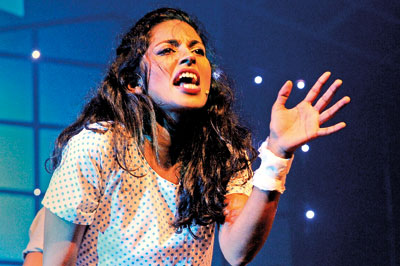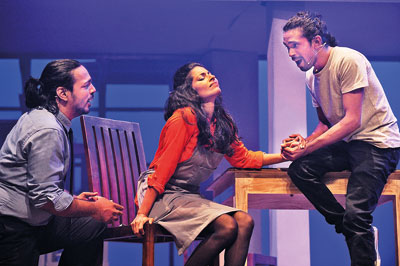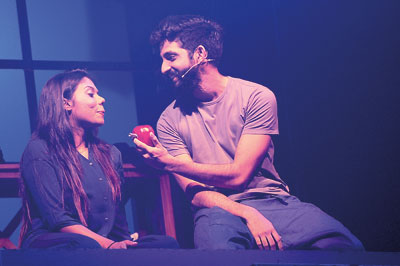A theme and production that struck hearts and minds

Complex emotions: Devashrie de Silva playing the role of Diana Goodman. Pix by Amila Gamage
If there is one thing the Theatre Junction production company cannot be accused of, it is Colombo’s habit of making much of easy things. They are distinctly contemporary and they are not afraid of taking on a challenge. Sisters Anushka and Natasha Senanayake, the vision and driving force behind the company, are not yet able to command the pomp and finesse of better known and admired directors of plays and companies. But their latest production “Next To Normal”, which took the Lionel Wendt by storm from September 29 to October 1, was proof that they are carving for themselves a path that is fresh and bursting with potential.
The production was remarkable in bearing what is becoming the signature of a Theatre Junction performance: a live band to accompany a full length Broadway musical in Colombo. The feat – no simple task to achieve – was handled with grace by Musical Director Natasha Senanayake. Senanayake is a versatile musician with extensive experience in composing and performing classical as well as contemporary music. Her particular experience brought sensitivity to the performance, and the production on the whole achieved a good balance of classical sweetness and jagged-edged rock; fitting for a story about a family torn by mental illness.
Live music inevitably has its pros and cons. Timing is slightly elastic, which is potentially a good thing, but served as not-so-good on opening night. There were many awkward pauses between numbers while actors took their places, or sometimes simply waited for the music to begin. This was most notable when Diana, after losing 19 years of her memory, storms up to her doctor in a fury (reprise of “You Don’t Know”), and soon after, when she accidentally stumbles upon her dead son’s music box (“How Could I Ever Forget?”).

Torn between her husband and memory of her son: L to r: Dan played by “CC” de Silva, Devashri as Diana and Damien Fernando as the illusion of their dead son Gabe
Anushka Senanayake is herself an experienced and qualified Director with a subtle touch. The action of the play was dramatic at times, but never disjointed from the emotional pace of the production.
“Next To Normal” took home three Tony Awards in 2009, including those for the Best Original Score and Best Orchestration. In 2010 the book was awarded the prestigious Pulitzer Prize for Drama.The success of the play hinged on the situation of the psychologically traumatized home that broke away from the typical glitz and glam of the “feel good” American musical. Theatre Junction demonstrated discretion in the choice of a highly successful play, and ambition in that of an emotionally very complex one.
The larger part of the responsibility for communicating this complexity of the “high highs” and the “low lows” of main character Diana Goodman’s bipolar disorder and schizophrenia, and the resulting impact on her family, fell to Devashrie de Silva.
As the play opened, the choreography and execution were excellent, the actors fluidly moving between speech and song. De Silva in particular excelled here, her sweet voice and coy smile drawing and sustaining the full attention of the unsuspecting audience. It is not until a good ten minutes into the play (“More… And More… And More”) that we begin to realize that Diana isn’t exactly “normal,” and the depth of her psychopathology and the “reality” of her relationship to her son Gabe only becomes evident much further on (“He’s Not Here,” ,“You Don’t Know”).
The character of Diana Goodman is incredibly complex and sensitively written. The role requires a nuanced performance that sustains a continuity and coherence between the depth of Diana’s depression and the heights of her mania in order to make the character believable, and to communicate her suffering as that of a single individual. Alice Ripley won the 2009 Tony Award for Best Performance by a Leading Actress in a Musical for her focused and continuous embodiment of Diana’s fluctuating state of being.

Doctor and patient: Devashri and Eraj Gunewardena as one of the many psychiatrists he portrayed
“Anger, yearning, sorrow, guilt and the memory of what must have been love seem to coexist in every note she sings,” wrote Ben Brantley for the New York Times.
Devashrie de Silva took possibly the most emotionally and musically demanding role she has yet played in a Broadway musical in her stride, giving it energy and sincerity while displaying the musical prowess that is her forte. Yet the inevitability of Diana’s oscillation between torn diva and suburban mom escaped the actress at times, manifesting in moments of forced and discontinuous performance. She did not fail though to communicate, and brought much of the audience to their feet, all three nights running.
Diana’s husband Dan was played naturally and emotively by Chrisantha “CC” de Silva who drew out the strength as well as weakness of his character with sensitively handled vocals, especially in “I Am the One” and “A Light in the Dark”. Diana and Dan’s daughter, Natalie, was portrayed by Sithara Pathirana who again demonstrated good vocal command. All three main players possessed musical strengths that outshone their performance as actors.The three remaining performers onstage demonstrated comparable vocal and theatrical strengths: Gyles Dharmaratne playing Natalie’s boyfriend Henry, Damien Fernando playing the illusion of Diana and Dan’s dead son Gabe and Eraj Gunewardena playing any number of doctors whom Diana goes through during the course of the play. Dharmaratne delivered impressive range with a gentle and nuanced performance while Gunewardena’s multiple roles were uniformly suave, played easily, with control. Fernando’s portrayal of Gabe was slightly more jagged-edged than one might have expected an illusion of lost innocence to be, but in his bright moments (most notably “I Am the One” and “I’m Alive”) he delivered with glitz and gusto.

The single set for the production was based on the original Broadway set, and complemented by lighting that was elemental for the most part. Dramatic touches of lighting at times cleverly amplified the humorous “rock star” moments between Diana and her doctor and at times formed the psychological background against which the household scenes were played out.
If nothing else, the elements were brought together by the skilled and sincere cast, to earnestly tell a story not often told: that of mental disorder and the questionability of what is “normal”. The theme struck hearts and energized minds, and Theatre Junction achieved the uncommon in Colombo: a good story, and well told.


